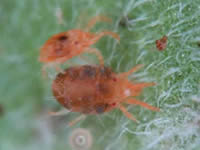
40th Meeting of the Panel on Phytosanitary Measures
Paris, 2008-02-19/22
The Panel met in Paris at the headquarters of the French NPPO. The main task of this Panel is to evaluate risks presented by specific pests and design phytosanitary measures to avoid their introduction and spread.
EPPO lists of pests recommended for regulation
On a case by case basis, the Panel reviewed the present situation and conclusions from PRA and made the following recommendations to the Working Party:
- Additions to the A1/A2 Lists:
Xanthomonas axonopodis pv. poinsettiicola (A1),
Pepino mosaic virus (A2),
Tetranychus evansi (A2).
- The Panel reviewed the Action List; it agreed that all pests listed for more than 5 years should be withdrawn.

Tetranychus evansi
(courtesy A. Migeon, FR)
Alert List
As usual, the Panel reviewed in detail the EPPO Alert List whose purpose is to warn countries about possible new risks, and in certain cases to propose candidates for PRA and eventually regulation. The Panel suggested emerging pests that should be added to the Alert List. Considering that the alert had been given and that no further action was needed, the Panel decided to delete: Aulacaspis yasumatsui, Ctenarytaina spatulata, Lygus lineolaris, Marchalina hellenica, Oligonychus perseae, Scolytus schevyrewi, Cylindrocladium buxicola, Eutypella parasitica, Plasmopara obducens, Raffaelea quercivora, Valsa ceratosperma.
Pest Risk Analysis
The Panel reviewed the PRAs produced by 2 Expert Working Groups (EWGs) for PRA and discussed how to improve the new PRA process. It recommended that EWGs should perform the management part of the decision support scheme but that the Panel on Phytosanitary Measures should also run this part in subgroups for the different pests and finalize the selection of management options.
For the following pests, the Panel recommended that PRAs should be conducted by EWGs: Tomato viroids, Meloidogyne minor and M. enterolobii, Chalara fraxinea (depending on the outcome of the consultation of the European Mycology Network and the Panel on quarantine pests for forestry), and Leucinodes orbonalis.
The Panel elaborated guidelines to review national PRAs to make recommendations to the Working Party. Ms Ceglarska (Co-ordinator of the EFSA Panel on Plant Health) had been invited to attend this part of the meeting to explain how the EFSA Panel has been developing a procedure for evaluation of pest risk assessments.
In 2009, the national PRAs for the following pests will be considered: Phytophthora kernoviae, Diaphania indica, Nysius huttoni.
Other topics
The Panel was presented the role and activities of EFSA, and in particular of the Panel on Plant Health by Ms Ceglarska.
Mr Boerma (NL) presented the system of electronic certification being implemented in the Netherlands, as well as the work done by the Commission on Phytosanitary Measures (CPM) working group on electronic certification, together with UN CEFACT.
